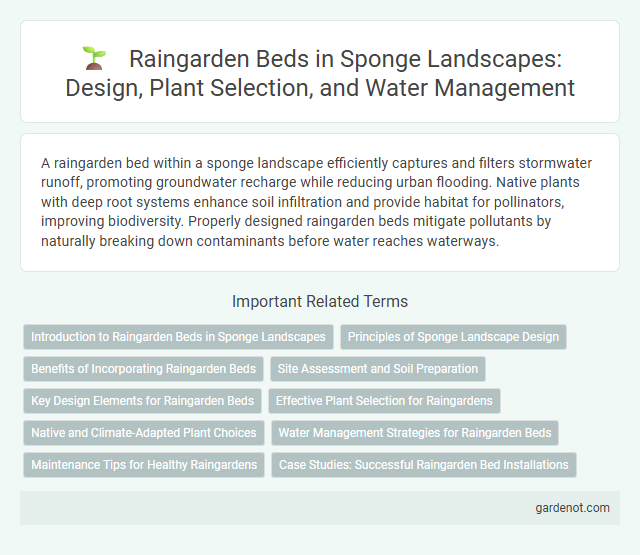A raingarden bed within a sponge landscape efficiently captures and filters stormwater runoff, promoting groundwater recharge while reducing urban flooding. Native plants with deep root systems enhance soil infiltration and provide habitat for pollinators, improving biodiversity. Properly designed raingarden beds mitigate pollutants by naturally breaking down contaminants before water reaches waterways.
Introduction to Raingarden Beds in Sponge Landscapes
Raingarden beds are essential components of sponge landscapes designed to manage stormwater runoff by capturing and filtering rainwater through permeable soil and vegetation. These beds reduce urban flooding, enhance groundwater recharge, and improve water quality by naturally absorbing pollutants before they enter storm drains. Incorporating native plants with deep root systems in raingarden beds optimizes water retention and supports local biodiversity within sustainable urban drainage systems.
Principles of Sponge Landscape Design
Raingarden beds in sponge landscape design effectively capture and filter stormwater using native plants and permeable soils that enhance infiltration. These beds reduce runoff volume and improve water quality by promoting natural groundwater recharge and pollutant removal. Integrating raingardens strategically within urban green spaces supports sustainable water management and mitigates flooding risks.
Benefits of Incorporating Raingarden Beds
Raingarden beds improve water management by capturing and filtering stormwater runoff, reducing soil erosion and protecting local waterways from pollutants. These sustainable landscaping features enhance groundwater recharge and support biodiversity by providing habitat for native plants and beneficial insects. Incorporating raingarden beds also helps mitigate urban heat island effects and lowers maintenance costs compared to traditional drainage systems.
Site Assessment and Soil Preparation
Site assessment for a raingarden bed involves analyzing soil permeability, slope, and drainage patterns to ensure optimal water infiltration and retention. Soil preparation requires amending the native soil with organic matter and sand to improve aeration, nutrient availability, and water absorption capacity. Correctly prepared soil enhances plant health and maximizes stormwater management efficiency in sponge landscapes.
Key Design Elements for Raingarden Beds
Raingarden beds incorporate native plants with deep root systems to enhance water infiltration and reduce runoff. Permeable soil media combined with engineered layers such as gravel facilitate optimal drainage and pollutant filtration. Strategic placement of overflow outlets ensures controlled water discharge, preventing flooding while promoting groundwater recharge.
Effective Plant Selection for Raingardens
Choosing native plants with deep, fibrous root systems enhances the filtration and absorption capacity of raingarden beds, promoting efficient stormwater management. Species such as sedges, rushes, and flowering perennials like Echinacea purpurea and Asclepias tuberosa thrive in alternating wet and dry conditions typical of raingardens. Incorporating diverse plant heights and textures not only maximizes pollutant removal but also supports local biodiversity and resilience against erosion.
Native and Climate-Adapted Plant Choices
Raingarden beds benefit from native and climate-adapted plant choices that enhance water absorption, reduce runoff, and support local biodiversity. Selecting plants such as switchgrass, blue flag iris, and red osier dogwood ensures resilience to regional weather patterns and soil conditions while providing habitat for pollinators. These species improve soil stability, filter pollutants naturally, and contribute to sustainable sponge landscape practices.
Water Management Strategies for Raingarden Beds
Raingarden beds utilize natural filtration and infiltration processes to manage stormwater runoff effectively, reducing surface flooding and improving groundwater recharge. Strategically designed with native plants and engineered soil mixes, these beds enhance water absorption while filtering pollutants, promoting sustainable urban drainage. Incorporating overflow outlets and underdrain systems further optimizes water retention and prevents oversaturation, ensuring efficient water management in sponge landscapes.
Maintenance Tips for Healthy Raingardens
Regularly remove accumulated debris and invasive weeds from raingarden beds to ensure proper water absorption and prevent clogging. Monitor soil moisture levels to maintain optimal hydration without oversaturation, promoting healthy plant growth. Periodically inspect inlet and outlet structures to avoid blockages that can compromise the raingarden's effectiveness in managing stormwater runoff.
Case Studies: Successful Raingarden Bed Installations
Case studies of successful raingarden bed installations highlight their effectiveness in mitigating urban runoff by filtering pollutants and reducing flood risks. Projects in Seattle and Portland demonstrate how native plants and strategic soil layering optimize water absorption and enhance biodiversity in sponge landscapes. These examples provide replicable models for sustainable stormwater management in varied urban environments.
Raingarden bed Infographic

 gardenot.com
gardenot.com